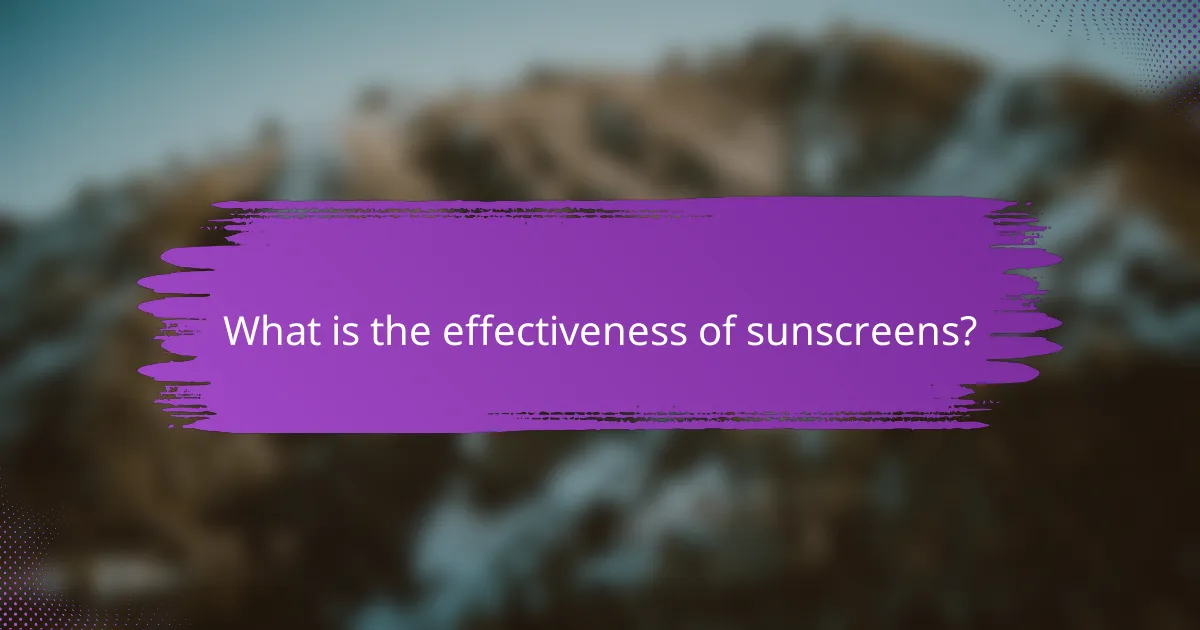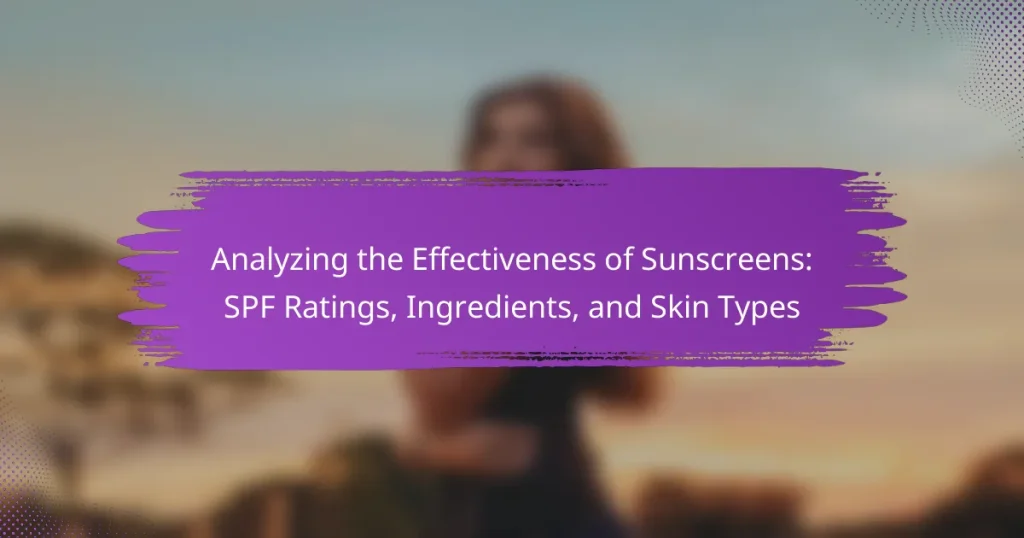Sunscreens are essential products designed to protect the skin from harmful ultraviolet (UV) radiation, primarily categorized into UVA and UVB rays. Their effectiveness is quantified by the Sun Protection Factor (SPF) rating, with higher values indicating better protection against sunburn and skin damage. Broad-spectrum sunscreens are particularly effective as they shield against both types of UV rays. Research, including findings from the Journal of the American Academy of Dermatology, highlights that regular sunscreen use significantly lowers the risk of skin cancer. The article will analyze the effectiveness of various sunscreens, focusing on SPF ratings, ingredient compositions, and their suitability for different skin types, emphasizing the importance of proper application and reapplication for optimal protection.

What is the effectiveness of sunscreens?
Sunscreens are effective in protecting the skin from harmful ultraviolet (UV) radiation. They work by absorbing, reflecting, or scattering UV rays. The effectiveness is measured by the Sun Protection Factor (SPF) rating. Higher SPF values indicate greater protection against sunburn and skin damage. Research shows that broad-spectrum sunscreens protect against both UVA and UVB rays. A study published in the Journal of the American Academy of Dermatology confirms that regular use of sunscreen reduces the risk of skin cancer. Proper application and reapplication enhance their effectiveness.
How is sunscreen effectiveness measured?
Sunscreen effectiveness is measured primarily by its Sun Protection Factor (SPF) rating. SPF indicates the level of protection against UVB rays, which cause sunburn. For example, an SPF of 30 means it would take 30 times longer for skin to burn compared to not using sunscreen. The testing is conducted under controlled conditions, typically involving human subjects. Researchers apply a standardized amount of sunscreen to the skin and expose it to UV radiation. The time taken for skin to redden is recorded. Higher SPF values result in a longer duration before skin damage occurs. Additionally, broad-spectrum labels indicate protection against both UVA and UVB rays. This measurement process is standardized by organizations such as the FDA and ISO.
What do SPF ratings indicate about sunscreen?
SPF ratings indicate the level of protection a sunscreen provides against UVB rays. A higher SPF number suggests greater protection. For example, SPF 30 blocks about 97% of UVB rays, while SPF 50 blocks approximately 98%. This means that using SPF 30 allows for 30 times longer sun exposure without burning compared to no sunscreen. SPF ratings help consumers choose appropriate protection based on their skin type and sun exposure risk. The American Academy of Dermatology recommends using a broad-spectrum sunscreen with at least SPF 30 for effective protection. Thus, understanding SPF ratings is crucial for effective sun safety.
How do different SPF levels affect protection?
Different SPF levels provide varying degrees of protection against UV radiation. SPF, or Sun Protection Factor, indicates the level of protection from UVB rays, which cause sunburn. An SPF of 15 blocks about 93% of UVB rays. An SPF of 30 blocks approximately 97% of UVB rays. An SPF of 50 blocks around 98% of UVB rays. Higher SPF levels offer marginally increased protection. However, no sunscreen can block 100% of UV rays. Proper application and reapplication are crucial for effective protection, regardless of SPF level. Studies show that many users apply sunscreen inadequately, reducing its effectiveness.
What are the key ingredients in sunscreens?
Key ingredients in sunscreens include chemical and physical filters. Chemical filters absorb UV radiation and convert it into heat. Common chemical filters are avobenzone, octisalate, and octocrylene. Physical filters, such as zinc oxide and titanium dioxide, reflect UV rays. These ingredients provide broad-spectrum protection against UVA and UVB rays. The effectiveness of these ingredients is supported by dermatological studies. For instance, the American Academy of Dermatology recommends sunscreens with at least SPF 30 for adequate protection.
What role do chemical ingredients play in sunscreen effectiveness?
Chemical ingredients are crucial for sunscreen effectiveness. They absorb, reflect, or scatter UV radiation. This action prevents skin damage from sun exposure. Common chemical ingredients include avobenzone, octisalate, and octocrylene. These substances provide broad-spectrum protection against UVA and UVB rays. Research shows that effective sunscreens contain a combination of these ingredients. For instance, a study published in the Journal of the American Academy of Dermatology highlights the importance of using multiple active ingredients for enhanced protection. This combination maximizes the sunscreen’s ability to shield the skin from harmful rays.
How do physical (mineral) ingredients compare to chemical ones?
Physical (mineral) ingredients in sunscreens, such as zinc oxide and titanium dioxide, provide broad-spectrum UV protection by reflecting and scattering UV rays. In contrast, chemical ingredients, like avobenzone and octisalate, absorb UV radiation and convert it into heat, which is then released from the skin. Mineral ingredients are often preferred for sensitive skin because they are less likely to cause irritation. Chemical ingredients may offer a lighter feel on the skin but can sometimes lead to allergic reactions. Studies show that mineral sunscreens can start working immediately upon application, while chemical ones typically require 20 minutes to become effective. Additionally, mineral ingredients are generally considered safer for marine life compared to certain chemical ingredients, which can contribute to coral bleaching.
How do skin types influence sunscreen effectiveness?
Skin types significantly influence sunscreen effectiveness. Different skin types absorb and react to sunscreen ingredients variably. Oily skin may lead to better absorption of certain formulations, enhancing effectiveness. Dry skin often requires thicker creams for adequate protection, which may reduce absorption. Sensitive skin may react negatively to some chemical sunscreens, leading to irritation and decreased usage. Fair skin types are more prone to sunburn, necessitating higher SPF for effective protection. Conversely, darker skin types have more melanin, providing some natural protection but still requiring sunscreen to prevent damage. Studies indicate that individuals with varying skin types should choose sunscreens tailored to their specific needs for optimal results.
What are the characteristics of different skin types?
Different skin types include normal, oily, dry, combination, and sensitive skin. Normal skin has a balanced moisture level and few imperfections. Oily skin is characterized by excess sebum production, leading to a shiny appearance and enlarged pores. Dry skin lacks moisture, resulting in flakiness and tightness. Combination skin exhibits characteristics of both oily and dry skin, often with an oily T-zone and dry areas elsewhere. Sensitive skin is prone to irritation, redness, and reactions to products. These classifications help determine appropriate skincare and sunscreen choices.
How can skin type affect sunscreen absorption and efficacy?
Skin type significantly influences sunscreen absorption and efficacy. Oily skin tends to absorb sunscreens differently than dry skin. Oily skin may enhance absorption due to increased sebum production, which can create a barrier for some formulations. Conversely, dry skin may require more moisturizing ingredients in sunscreen for proper absorption. Sensitive skin types may react negatively to certain chemical filters, reducing efficacy. Research indicates that formulations with physical blockers, like zinc oxide, may be better tolerated by sensitive skin. Additionally, skin hydration levels can affect how well sunscreen adheres and penetrates the skin. A study published in the Journal of Investigative Dermatology found that skin hydration positively correlates with the effectiveness of UV protection.
What are common misconceptions about sunscreen?
Common misconceptions about sunscreen include the belief that it is only necessary on sunny days. Sunscreen should be applied every day, regardless of the weather. Another misconception is that a higher SPF provides significantly better protection. SPF 30 blocks about 97% of UVB rays, while SPF 50 blocks about 98%. Many people think they can skip reapplication if they use a water-resistant formula. However, reapplication is required every two hours or after swimming or sweating. Some believe that sunscreen is not needed for darker skin tones. In reality, all skin types can suffer from UV damage. Lastly, some think that sunscreen is sufficient alone for sun protection. Wearing protective clothing and seeking shade also play critical roles in sun safety.
Why do people underestimate the importance of sunscreen?
People underestimate the importance of sunscreen due to a lack of awareness about skin damage. Many individuals are unaware that UV radiation can cause skin cancer and premature aging. Research indicates that skin cancer is the most common cancer in the United States. According to the Skin Cancer Foundation, one in five Americans will develop skin cancer in their lifetime. Misconceptions also exist regarding skin types and the belief that darker skin does not need sunscreen. However, all skin types can suffer from UV damage. Additionally, some people believe that sunscreen is only necessary on sunny days. In reality, harmful UV rays can penetrate clouds and cause damage even when it is overcast.
How can misinformation about SPF ratings lead to misuse?
Misinformation about SPF ratings can lead to misuse by creating false perceptions of sunscreen efficacy. Many consumers may believe that a higher SPF offers significantly more protection than lower SPFs. This misconception can result in inadequate application or reapplication of sunscreen. For instance, individuals might rely solely on a high SPF product and neglect other protective measures like seeking shade or wearing protective clothing. Studies show that improper use of sunscreen increases the risk of sunburn and skin damage. Additionally, misinformation can lead to overexposure to the sun, as users may feel overconfident in their protection level. This can ultimately contribute to a higher incidence of skin cancer and other skin-related issues.
What are the best practices for applying sunscreen?
Apply sunscreen generously to all exposed skin. Use about one ounce for full body coverage. Apply it 15 to 30 minutes before sun exposure. Reapply sunscreen every two hours, or immediately after swimming or sweating. Choose a broad-spectrum sunscreen with at least SPF 30. Ensure to cover often-missed areas like ears, feet, and the back of the neck. Use sunscreen even on cloudy days, as UV rays can penetrate clouds. Check expiration dates to ensure effectiveness.
How much sunscreen should be applied for optimal protection?
For optimal protection, at least one ounce (about a shot glass full) of sunscreen should be applied. This amount covers the entire body effectively. It is essential to apply sunscreen generously to ensure full coverage. Studies indicate that insufficient amounts can lead to decreased protection. The American Academy of Dermatology recommends reapplying every two hours, especially after swimming or sweating. Proper application and reapplication are crucial for maintaining effective sun protection.
When should sunscreen be reapplied for maximum effectiveness?
Sunscreen should be reapplied every two hours for maximum effectiveness. This recommendation is based on studies showing that sunscreen loses its effectiveness over time due to factors like sweating, swimming, and towel drying. Additionally, if you are in direct sunlight for extended periods, reapplying every 80 minutes is advisable. According to the Skin Cancer Foundation, this practice helps maintain adequate protection against harmful UV rays.
How can individuals choose the right sunscreen for their needs?
Individuals can choose the right sunscreen by considering their skin type, SPF rating, and ingredients. Different skin types require specific formulations. For example, oily skin benefits from oil-free or gel-based sunscreens. Dry skin may need cream-based formulations for added moisture.
SPF ratings indicate the level of protection against UVB rays. A minimum SPF of 30 is recommended for most individuals. Higher SPF values provide increased protection but do not allow for prolonged sun exposure.
Ingredients play a crucial role in effectiveness. Broad-spectrum sunscreens protect against both UVA and UVB rays. Look for active ingredients like zinc oxide or titanium dioxide for physical protection. Chemical sunscreens may contain avobenzone or octisalate for absorption of UV radiation.
Individuals should also consider water resistance if engaging in swimming or sweating. Sunscreens labeled as water-resistant can provide protection for up to 80 minutes in water. Always check expiration dates to ensure the product’s efficacy.
What factors should be considered when selecting a sunscreen?
When selecting a sunscreen, consider the SPF rating, broad-spectrum protection, and skin type compatibility. SPF rating indicates the level of UVB protection. A higher SPF provides more protection from sunburn. Broad-spectrum protection safeguards against both UVA and UVB rays. This is crucial for preventing skin damage and aging. Skin type compatibility is essential for effectiveness and comfort. For oily skin, choose gel-based or non-comedogenic formulas. For dry skin, opt for moisturizers with sunscreen. Ingredients are also important; look for zinc oxide or titanium dioxide for physical blockers. Chemical sunscreens may contain avobenzone or octisalate. Ultimately, selecting a sunscreen involves evaluating these factors for optimal skin protection.
How can one determine the best sunscreen for their skin type?
To determine the best sunscreen for your skin type, assess your skin’s characteristics first. Identify if your skin is oily, dry, combination, or sensitive. Look for sunscreens labeled as non-comedogenic for oily skin. For dry skin, choose moisturizers with hydrating ingredients like hyaluronic acid. Sensitive skin benefits from mineral sunscreens with zinc oxide or titanium dioxide. Check the SPF rating; a minimum of SPF 30 is recommended for adequate protection. Review the ingredients to avoid allergens or irritants specific to your skin. Conduct a patch test before full application to ensure compatibility.
The main entity of the article is sunscreens, which are essential for protecting the skin from harmful ultraviolet (UV) radiation. The article provides an in-depth analysis of sunscreen effectiveness, focusing on SPF ratings, key ingredients, and the influence of various skin types on protection. It covers how SPF ratings indicate the level of UVB protection, the role of both chemical and physical ingredients, and the importance of choosing the right sunscreen based on individual skin characteristics. Additionally, it addresses common misconceptions about sunscreen use and offers best practices for application and reapplication to ensure optimal skin safety.


